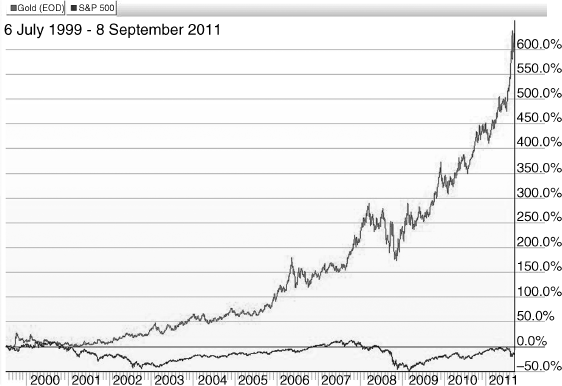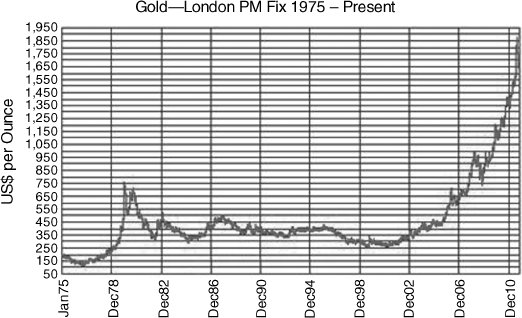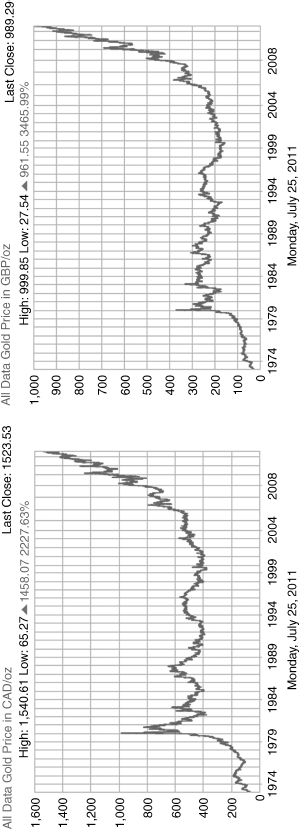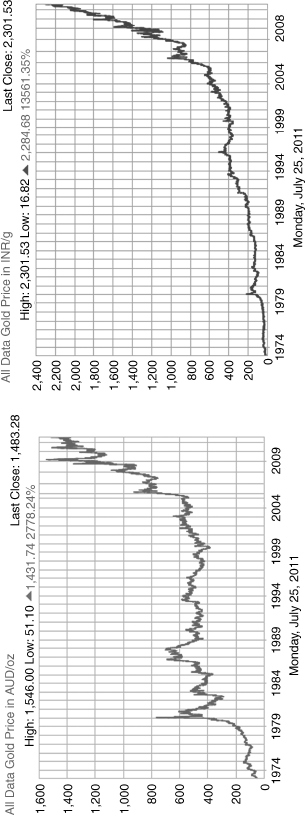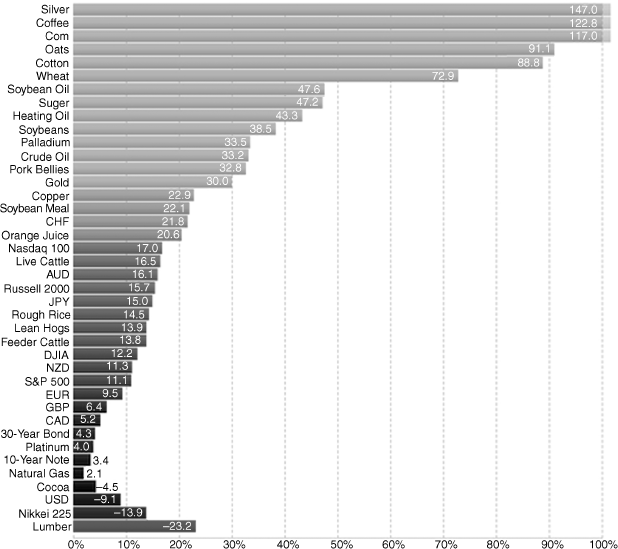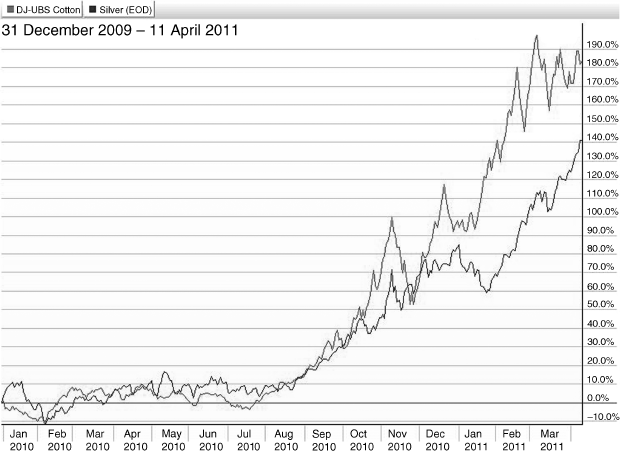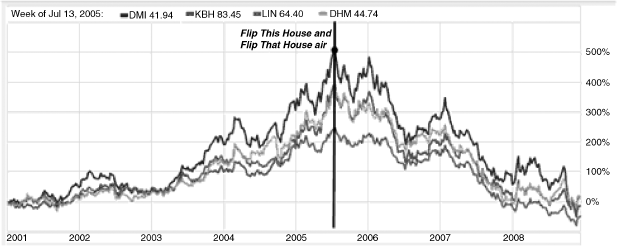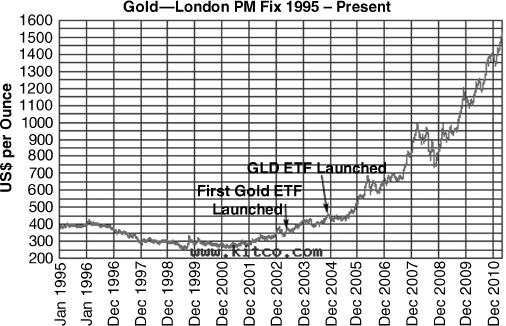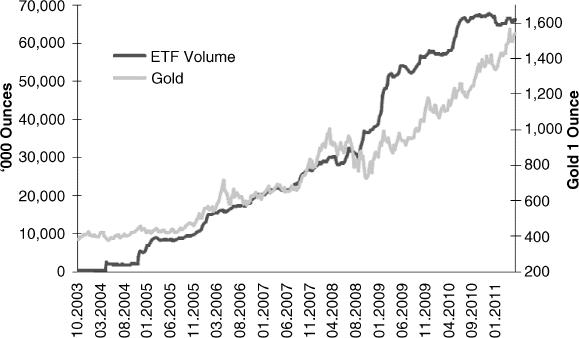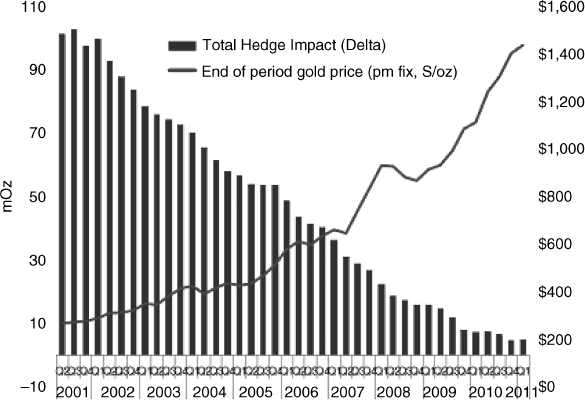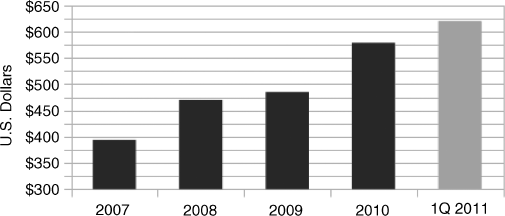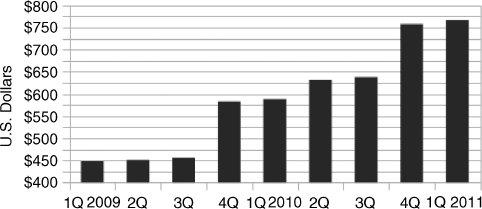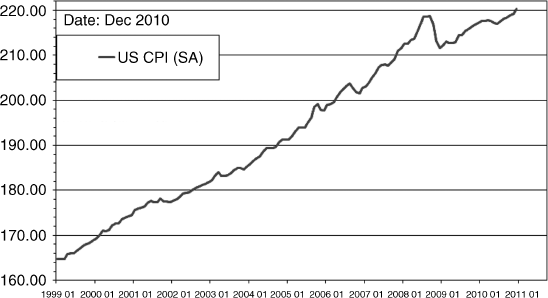Chapter 3
Signs of a Gold Bubble
Bull markets are born on pessimism, grow on skepticism, mature on optimism, and die on euphoria.
—John Templeton, mutual fund pioneer
Indications of a bubble in gold encompass a very wide range of symptoms. More than just the extreme price movement, the signs of a gold bubble include overspeculation, extreme expectations, and massive publicity. This chapter explains why gold is in a bubble.
Economists use the term bubble to mean any deviation in the price of an asset or a security or a commodity that cannot be explained in terms of the “fundamentals.”1
—Charles Kindleberger
Since bubbles are defined by the tremendous and parabolic price movements in the underlying asset of speculation, the first place to spot a bubble is in a price chart. When prices rise at a steady rate, they are more sustainable than when they show sharp, sudden, or steep price increases, which are accompanied by greater risk and unsustainability. In other words, you generally do not want to buy a stock or asset that has soared in a dramatic fashion, where a sharp fall or collapse is increasingly likely. The steeper the angle of ascent, the sharper the fall.
In our case of gold, the parabolic price increase is clear in the charts. While gold has soared over 600 percent from the 1999 lows, the stock market has seen severe ups and downs and zero gains in over 11 years. See Figure 3.1.
Gold prices have exploded upwards from near $250 an ounce to above $1,900 an ounce in 11 years! For an asset that has been the main source of value for thousands of years and throughout the history of civilization, such a massive move requires a radical shift in circumstances. We do potentially have that radical shift underway, but it's unlikely that the chaos of our current state of affairs is any more extreme than the massive upheavals that have been encountered throughout history—such as World War I or II, the Great Depression, or other major financial panics. And even if a radical shift is underway, mainly in a currency-system collapse, who says gold will become the default currency? If anything, gold's massive rise has been fueled by excess liquidity and unwarranted money-printing, which has turned gold into a speculative commodity rather than a stable form of currency.
Some have even claimed that the 600 percent move for gold isn't extreme. These gold enthusiasts have attempted to refute the similarity between the current gold bull market and other bubbles such as the dot-com bubble of the late 1990s or the housing bubble that peaked in 2006 to 2007. One of the arguments presented by gold bugs is that the price of gold has not yet increased in parabolic form. Perhaps they are waiting for a move of a few thousand percent, but they fail to realize that gold has not only moved parabolically since 1999, but is up thousands of percentage points since the early 1970s.
How is Figure 3.2 not a parabolic move? It's almost vertical—and definitely not sustainable.
Moreover, gold may be up only 600 percent in U.S. dollar terms since 1999, but it is up over 5,000 percent in U.S. dollar terms since 1968, over 2,700 percent in Canadian dollar (CAD) terms, over 3,400 percent in Australian dollar (AUD) terms, over 4,000 percent in British pounds sterling (GBP), and over 16,000 percent in Indian rupee (INR) terms! The claim that we haven't seen extreme price increases is absurd. Notice the nearly vertical price surges in Figure 3.3.
If we compare the current commodity price surge to the tremendous moves over the past 200 years, can we really say with certainty that this time will be different? Every other time commodity prices have risen this quickly, they have seen sharp declines. There appears to be a cyclical pattern in commodities, as in economies and markets; and we may be at the top of the current cycle. See Figure 3.4.
Figure 3.4 Is This Time Different?
Source: Hackett Financial Advisors; Maclean's (www2.macleans.ca/wp-content/uploads/2011/03/commodity-chart11.jpg).
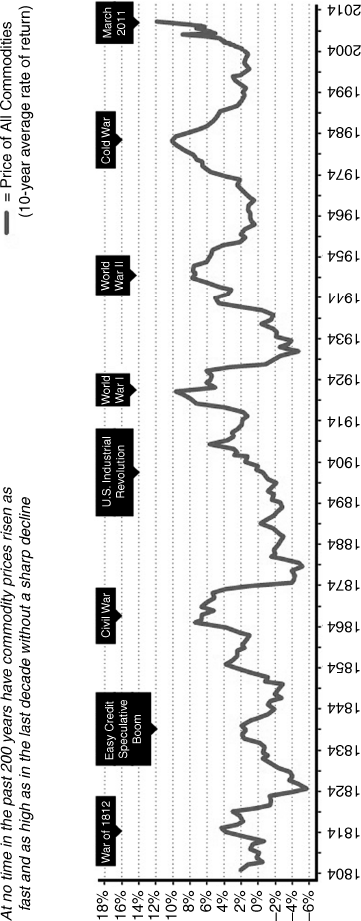
Just take a look at the recent massive outperformance of gold and commodities over the stock market, shown in Figure 3.5. Are these increases sustainable?
For another example of how the commodity space has soared in a drastic fashion, take a look at Figure 3.6 to see how dramatically cotton and silver prices rose in 2010 and early 2011. With such a basic material as cotton increasing 190 percent in a little over a year, and an important metal such as silver rising over 140 percent, the commodity space definitely looks frothy. And gold may be the biggest player in this theme. Note that cotton is represented by the top line, and silver by the bottom line.
Because the print and electronic media are midwives to the birth of investment crowds, we have the opportunity to watch crowds develop from toddlers to mature adults just by monitoring media content.2
—Carl Futia
For a speculative bubble to form and expand, a few core requirements must be met. First, there must exist a small number of individuals or investors who profit from a specific investment. Then, a second wave of investors must see the profits made by the first group and invest in the same asset in hopes of realizing profits similar to group one. The longer the speculative bubble lasts, the higher the number of waves or groups of investors that will participate. Most important, however, is that each successive wave of investors sees smaller and smaller profits and is accepting more risk than the group before it. In other words, the first ones to hear about or invest in this investment theme were the true leaders whose potentially big profits convinced many investors to follow in their footsteps and attempt to repeat their success; but the attempt to repeat the successes of previous investors is often met with failure, and those individuals who jump on the train too late can suffer huge losses.
It is therefore the transfer of investing enthusiasm from one individual to the next that makes the bubble develop and expand. The expansion is accomplished through what has been termed an “information cascade”: As stories of profits proliferate via personal accounts or media coverage, information regarding the investment theme is transferred; and as that information transfer continues and grows, it sparks a lot of interest and enthusiasm among potential investors, thereby expanding the bubble.
This transfer of enthusiasm from one individual to the next is also known as a psychological feedback loop: One person's gains and excitement convince another person to attempt person number one's investment, which in turn convinces another person, and so on. This psychological feedback loop is the carrier of speculative bubbles, transmitting speculative fever from one person to the next.
In the words of Yale professor and highly acclaimed speculative-bubble spotter, Robert Shiller:
Irrational exuberance is the psychological basis of a speculative bubble. I define a speculative bubble as a situation in which news of price increases spurs investor enthusiasm, which spreads by psychological contagion from person to person, in the process amplifying stories that might justify the price increases and bringing in a larger and larger class of investors, who, despite doubts about the real value of an investment, are drawn to it partly through envy of others' successes and partly through a gambler's excitement.3
Psychological feedback loops are not present only in the expansion of the bubble; they also exist as the bubble collapses, spreading fear and panic as prices tumble even below long-term averages. In other words, just as the feedback loop made investors overreact to the upside, so too will it make them overreact to the downside.
So how does this apply to gold?
Since the bull market in gold has lasted for over 11 years now, there has been plenty of time for success stories of the initial investors in gold to proliferate throughout the rest of the investing world. After a period of relative success, the next wave of investors joined the gold bandwagon. Then came the introduction of gold ETFs, which made investing in gold easier and more accessible to the average investor. With the addition of factors such as financial turmoil, plunging stock prices, and increasing media attention, gold has been able to continually expand as a “surefire” investment theme. But with the possibility that investor and media enthusiasm is at an extreme, the gold bubble could be reaching its peak.
Here's how Carl Futia, self-described contrarian, explains the influence of first-investor success stories:
This is a nearly universal characteristic of investment crowds. Any social group's growth is fed by the success of its founding members. An investment crowd's growth is stimulated by the financial success of its early adherents. They have gotten rich from a dramatic upward move in the price of some asset.4
It is exactly these success stories combined with human greed, in attempting to copy others' success, that keep these speculative bubbles going:
Crowds develop and grow during a communication process called an information cascade. During an information cascade the print and electronic media focus public attention on recent, dramatic movements in markets and the associated profits and losses of investors. This in turn encourages people to put aside their natural skepticism and adopt the investment theme the media are highlighting. As the investment crowd thus grows larger, it pushes the market even further away from fair value and toward a substantial valuation mistake.5
Moreover, it is the big price change in the asset that the crowd then relies on as proof of further gains. And although betting on future price increases based on large run-ups that have already occurred is counterintuitive and risky, the speculative bubble crowd uses these faulty arguments as proof of its correctness.
The crowd then continues to grow as institutional investors, investment gurus, and average investors join. The continuous coverage of success stories, hopes of extreme future profits, and the comfort of being part of an investment crowd with numerous and prominent members, all contribute to these investors' false beliefs that their investments are sound and that their arguments are well-supported.
But the crowd cannot be right forever. At some point there just aren't any profits to be made because everyone has attempted to profit from the same thing. The arguments that were made in support of the investment may have been based on true statements and forecasts, but the high prices to which the underlying asset has been pushed are no longer justified. In other words, investors were correct in that what they invested in should rise; but the excitement and frenzy over their investments pushed prices to extremes—which were no longer justified by their original arguments in support of those investments.
It is at this time that the speculative bubble is at risk of deflating. So long as the crowd's success continues, and money is still being made, the bubble can continue to grow by attracting new investors. But once profits begin to wane or there are few if any investors left to join the crowd, the bubble begins to implode. Not much different from a Ponzi scheme, the end of new-investor participation marks the end of the run, and it is many of the last investors to get in who suffer the greatest losses.
The collapse of the speculative bubble picks up steam on the way down just as the bubble picked up steam on its way up.
Because an information cascade is so fragile, the growth of an investment crowd is likely to halt as soon as the above-average returns to its investment theme fail to materialize. This will happen as a natural consequence of the significant divergence of the market price from fair value that has resulted from the crowd's investment activities. And as soon as the crowd's growth stops, there will then be a trickle of members who lose faith in the crowd's theme. As they leave the crowd, the market price will slowly begin to drift back toward fair value. At that point the information cascade that built the crowd will begin to run in reverse and the trickle of disillusioned members will become a flood.6
So, if Figure 3.7 maps the stages of a bubble, where do we currently stand with gold?
Figure 3.7 Stages of a Bubble
Source: Jean-Paul Rodrigue, http://canadianfinanceblog.com/is-the-current-market-a-return-to-normal/.
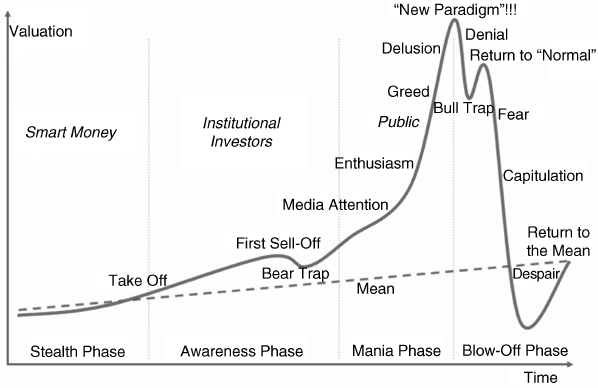
We have undoubtedly passed the “stealth” phase in which the first smart-money investors bought gold over 10 years ago. We have also passed the “awareness” phase, in which institutional investors jumped on board before the majority of the public; the introduction of the gold ETFs approximately six years ago probably took place during this phase. We then entered the “mania” phase, in which increasing media attention, public enthusiasm, and—likely—greed and delusion have taken place. There is still a possibility of a rapid “blow-off” phase where prices will shoot up for a short period, tricking the final investors to get in before the bubble ultimately collapses. It is still unsure if the top has been reached; but we are nearing or have already reached the arguments of gold investment as a “new paradigm.” Caution is highly warranted.
Media Frenzy
Even more significant are new TV series that appear just as an associated crowd is about to begin its disintegration process.7
—Carl Futia
There is no doubt that gold has become the focus of much attention over the past couple of years. The price has soared, it has become the number one source of “protection” from currency devaluations and economic turmoil, and it is the center of discussion in much of the financial media. It is by following the exuberant media coverage of gold that we can better understand the psychology and speculative behavior of the crowd.
Huge publicity may signal the top. If widespread media coverage is a sign of investment saturation and peak of popularity, gold may be nearing the top. Gold has made the front page of the Wall Street Journal, has become the topic of much financial media discussion, and has even been the subject of a popular TV show entitled Gold Rush: Alaska.
Is TV Signaling a Top in Gold?
Television may be signaling a top in gold in a similar way it signaled a top in housing.
At the height of the housing craze, with the “unlimited potential” involved in rising real estate prices, some investors pocketed huge gains by “flipping” houses. By purchasing houses that either needed repair or were simply selling at a discount to market valuations, investors were able to renovate the houses or quickly resell them for considerable gains. This method, or strategy, became so lucrative for some investors, that buying houses to actually live in or sell years down the road no longer proved necessary; “flipping” was the new fad.
And flipping was not only deemed lucrative for the few who had real estate expertise. Starting in July 2005, with home prices already up a few hundred percent in many areas, television networks began documenting and promoting the flipping process for those who hadn't yet caught on. First, on July 14, the Discovery Channel premiered Flip That House, documenting the renovation of a Las Vegas home that was to be flipped. Next, on July 24, Flip This House (note the very original title) was aired on A&E, following a Charleston-based real estate company focused on doing the same. It seemed as if the doors were opened for the next generation of real estate speculators.
But as is the case with most lucrative investment themes—they don't last forever. And not only do they not last forever, but they can also prove to be highly damaging for those who miss the boat and get in too late. In fact, the week that Flip That House made its premier was the exact top in the housing market! Not just a warning signal or a precursor to the ultimate peak, but the exact top!
Take a look at Figure 3.8. As you can see, homebuilders such as DR Horton (DHI), KB Home (KBH), Lennar (LEN), and PulteGroup (PHM) saw gains as large as 500 percent in less than four years as the housing market uproar sent real estate prices soaring. But after the massive gains, the ultimate top was reached the week of July 18, 2005—the exact time that flipping became the “norm.” The rest we are familiar with: those who failed to get out in time saw their investment value nearly disappear, the housing bubble collapsed, and the market spiraled downwards as investors fled to the exits. Television, with its focus on informing the masses, had signaled the top; flipping was no longer a secret.
If the media craze about housing was a model for any future fads, we may be in the midst of another bubble yet to be popped—the gold bubble. Never mind the slew of reasons why gold looks dangerous here. But if you weren't concerned until now, maybe the TV bubble-signals will convince you.
On December 3, 2010, the Discovery Channel premiered its new show Gold Rush Alaska. Just like their 1849 California Gold Rush predecessors had done, the men portrayed in this new show will leave their homes and risk their lives in search of big profits as they dig for gold in Alaska. Yet while they may end up turning a considerable profit, especially since the show has already been recorded while the gold bubble was still raging, the “Gold Fever” may soon be over. And that's not to say that operating a mine is equal to flipping a house, in that it is probably much easier for the average person to flip a house than to mine for gold; but the portrayal of potential profits to be had by getting involved in the gold theme is definitely akin to the potential profits that were presented in the housing shows.
If Flip This House and Flip That House signaled the peak of the speculative bubble-hunting in the housing market, Gold Rush Alaska may prove to do the same for the gold bubble, which may have started for the right fundamental reasons and which has made a considerable profit for a numerous bunch, but which may ultimately end in disaster for those who have joined the party too late.
As I've mentioned above, the housing bubble peaked and began its collapse at the exact time that TV shows were portraying the “house-flipping” process to the masses. If Gold Rush Alaska is our second TV bubble-signal, the gold bubble is near its peak.
Wall Street Journal Warning Signal
In addition to TV media, the print media has embraced the gold theme as well. And with the Wall Street Journal displaying gold as the cover story in late 2010, the end may be near.
In the early 1970s Paul Macrae Montgomery observed that when Time magazine had a cover story about a prominent business personality, about the stock market, or about some other finance-related matter, one could often infer that an important move in the markets was imminent, a move that was likely to be in the direction opposite to what the cover suggested. Optimistic covers led to unexpected drops in prices, while pessimistic covers had the opposite effect.8
Though the study by Montgomery involves Time magazine, the same observation could be made about the Wall Street Journal: when a story makes the front page of a well-known newspaper or magazine, it signals widespread recognition of that story or theme. Since heavily distributed newspapers and magazines tend to reflect the widespread sentiment of its readers and the general population, a front-page headline signals broad acceptance of that idea.
It's been a fairly long-standing negative omen for the market when major cover stories marvel at the wondrous bull-market run-ups and, inversely, a positive omen for the market when cover stories mourn the death of markets. That said, positive cover stories regarding investment themes are bad omens, signaling an upcoming pause or correction, if not an end to that theme.
A simple book search would reveal the massively one-sided bullish sentiment in gold. Since 2007, numerous books have been published about gold and its tremendous potential for profits. Yet while all of these books have been encouraging investors to buy gold for the long-term, and have been written by industry-leading economists, investment professionals, and even government officials (such as Robert Kiyosaki, author of Rich Dad, Poor Dad; financial historian and economist Peter Bernstein; former Chairman of the Federal Reserve Paul Volcker; commodity icon Dennis Gartman; congressman and presidential candidate Ron Paul; author and investor Peter Schiff), there are currently zero books warning investors about the tremendous risks involved in gold.
If mass mood in this case is extreme optimism regarding gold, it may be nearing the end of its run. At the very least, the TV series and heavy media attention signal that the mania phase is well underway.
There is nothing as disturbing to one's well-being and judgment as to see a friend get rich. Unless it is to see a nonfriend get rich.9
—Charles Kindleberger
Aside from the gold price itself, we can measure and observe speculative fever in a number of ways:
“We Buy Gold” Everywhere
In the past two years, there have been more “Sell Your Gold” commercials and “We Buy Gold” stores than ever before—not to mention all the gold and silver ads located all over the Internet. It seems as if everywhere I go I see some kind of reference to gold. The prevalence of these stores and commercials not only points to market saturation and mass public awareness, but also to the massive spotlight that has been shining on gold. Massive publicity of a profitable investment theme or business model generally signals oversaturation and the end of profitability. If “We Buy Gold” and “Cash for Gold” are an indication of mass public awareness, we may be nearing the end of the run for profitability in gold. And since the end of profitability means sideways price movement or a decline, gold prices are at high risk of reaching a peak and falling. The addition of overspeculative bubble behavior makes the potential fall exponentially more devastating.
Famous stories have been told about Joe Kennedy avoiding the Wall Street Crash of 1929 because receiving stock tips from a shoeshine boy signaled to him that it was time to sell. Other stories have been told about taxi drivers recommending technology stocks at the peak of the technology bubble. Recently, my barber started buying and selling gold. I am not saying that shoe-shiners, taxi drivers, and barbers are incapable of making good investment decisions, but when people who generally have little or no financial and investment background start buying and selling gold, warning signs should be flashing.
Coin Sales
Authorized under the Gold Bullion Coin Act of 1985, and first released by the United States Mint, American Gold Eagle coins have been sold to the public since 1986. Together with American Silver Eagles, the sales of these coins have fluctuated widely and may offer us some insight into the amount of speculation and interest in precious metals, as well as future prices.
As you can see in Figure 3.9, sales of American Gold Eagle coins show three distinct peaks.
Figure 3.9 American Eagle Sales since 1986
Source: Erste Group Research, “Special Report Gold: July 2011,” 38.
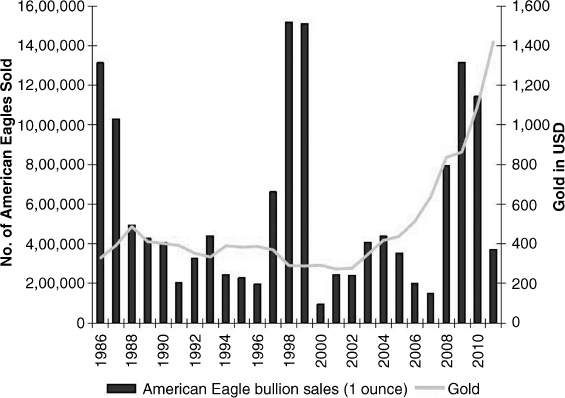
 The first peak, in 1986 to 1987, can be attributed both to a spike in interest due to the introduction of these coins, as well as high interest due to the rise in gold prices from 1985 to 1988. Notice, however, that as gold prices continued to rise in 1987, the higher prices and/or declining interest in gold resulted in a lower number of sales of coins. The lower sales number as prices of the underlying gold actually rose may have forewarned of an upcoming fall in gold itself.
The first peak, in 1986 to 1987, can be attributed both to a spike in interest due to the introduction of these coins, as well as high interest due to the rise in gold prices from 1985 to 1988. Notice, however, that as gold prices continued to rise in 1987, the higher prices and/or declining interest in gold resulted in a lower number of sales of coins. The lower sales number as prices of the underlying gold actually rose may have forewarned of an upcoming fall in gold itself.
 The second peak, 1997 to 1999, came as gold prices reached a multidecade low. After collapsing since the early 1980s, gold fell to $252 an ounce in 1999. The huge number of coin sales, as seen by the spike, is likely the result of tremendously cheap prices—those who purchased the coins could afford much more with gold at $250 an ounce than they did when gold was at $400 or $500 an ounce a few years earlier.
The second peak, 1997 to 1999, came as gold prices reached a multidecade low. After collapsing since the early 1980s, gold fell to $252 an ounce in 1999. The huge number of coin sales, as seen by the spike, is likely the result of tremendously cheap prices—those who purchased the coins could afford much more with gold at $250 an ounce than they did when gold was at $400 or $500 an ounce a few years earlier.
Once again, the massive spike in coin interest could have signaled a reversal in gold prices. With a sudden spike and higher sales in 1997 than any year in the more than 10-year history of these coins, the renewed spike in interest was a sign that the bottom may be close. 1997 was not the bottom, just as the 1987 divergence was not the exact top. But the spike in 1997 and the huge follow-up interest in 1998 and 1999 were strong signals that the end of the drop in prices was near. Gold did in fact bottom-out near $250 both in 1999 and early 2001 and has never looked back—yet.
 The third peak, where we find ourselves now, has taken place since 2008. After falling considerably throughout 2008, gold has more than doubled from its sub-$700 low in late 2008 to above $1,900 in 2011. Yet though the 2008 spike in coin sales may have signaled renewed buying interest in coins and the underlying gold itself, we are again seeing negative divergences with 2010 sales being lower than 2009 sales. Again, the sales number is likely affected by the higher gold prices in 2010—which has made gold less affordable; but if history has shown us a pattern, in the case of sudden spikes and divergences in coin sales, when the sales of coins fails to follow the trend in actual gold prices, a significant gold price reversal may be due.
The third peak, where we find ourselves now, has taken place since 2008. After falling considerably throughout 2008, gold has more than doubled from its sub-$700 low in late 2008 to above $1,900 in 2011. Yet though the 2008 spike in coin sales may have signaled renewed buying interest in coins and the underlying gold itself, we are again seeing negative divergences with 2010 sales being lower than 2009 sales. Again, the sales number is likely affected by the higher gold prices in 2010—which has made gold less affordable; but if history has shown us a pattern, in the case of sudden spikes and divergences in coin sales, when the sales of coins fails to follow the trend in actual gold prices, a significant gold price reversal may be due.
An even more extreme example of coin sales signaling a bubble is that of silver coins, shown in Figure 3.10.
Figure 3.10 American Eagle Silver Coin Sales (12 Months Rolling)
Sources: U.S. Mint, Deutsche Bank (March 2011). Retrieved from Business Insider.
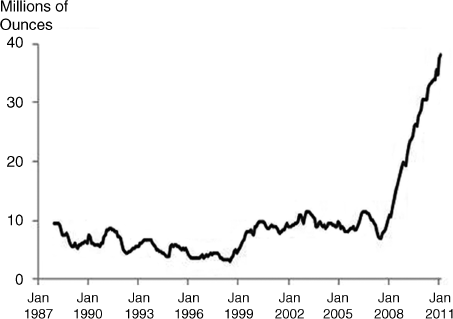
Silver coin sales have fluctuated widely as well, but showed an outlandish and almost ridiculous spike from late 2007 until early 2011. Silver coin sales may have soared to such higher levels largely due to their much more affordable prices in comparison to gold. However, the huge spike—nearly four times greater than any since the coins started selling in 1987—should have been a grave warning signal to silver investors. Not only did the tremendous spike forewarn of a potential upcoming silver price reversal (which took place a few months later, in May 2011, and sent silver prices down 40 percent); but the huge speculative fever visible in silver coin sales should forewarn us of a broader speculative bubble in precious metals—especially gold.
Investment Demand
One of the clearest measures of the rise in speculative interest in gold could be the amount of gold demanded for investment. Investment demand could be seen as a measure of popularity and speculative interest, since investment demand rises or falls with the popularity of gold. And since highest investment demand generally comes near peaking popularity, a very large and disproportional rise in investment demand may signal that popularity is peaking and prices may soon drop. In simple terms, if investment demand for gold rises substantially and to fairly extreme levels, it may be time to get out of gold.
In 2000, when the gold bubble was just starting, investment demand was only 4.8 percent of total demand. By 2010, it accounted for nearly 40 percent.10 With a huge yearly increase of 35 percent in investment demand for 2010 and a dramatic surge in investment demand as percent of total demand from 2000 to 2010, the gold space appears to be highly speculative. Gold bugs would tell you that a huge surge in investment demand is a bullish sign that means investors are finally embracing gold. But with investment demand now making up 40 percent of total demand, it is, in my opinion, far clearer that the huge rise in investment is a sign of mass speculation.
The Dangers of Physical Gold and Silver
The huge growth in physical gold and silver buying is both a sign of mass speculation and an indication of much greater risk taken by investors. With the option of investing in gold either through ETFs or through physical gold, many have chosen to buy the physical kind. Physical gold provides the investor with the actual gold, rather than just some number appearing on his or her computer screen. However, an investment in physical gold can be costlier (due to premiums charged by the sellers) and much less liquid than an ETF investment. If gold prices start to plunge, an investment in the gold ETF would be much easier to dispose of than physical gold (though not necessarily easy). ETFs provide liquidity since the exchange between buyer and seller is much easier and the seller has access to an entire world of buyers through the stock exchange. On the other hand, someone trying to sell physical gold as gold prices plummet would have a much more difficult time finding buyers and fair prices. Though a collapse of gold ETFs is possible due to shady ETF prospectuses and insufficient gold holdings to back up the funds, physical gold and silver could leave many investors stuck with an asset that is falling in price with no one to sell it to.
The University of Texas has taken physical delivery of $1 billion worth of gold, and countries like Mexico, South Korea, and Russia have been large net buyers of gold in 2011. Though these actions are an attempt to capitalize on a continued increase in gold prices, the decision to buy gold or accept physical delivery may have been made too late. If the gold bubble collapses, these gold holdings will lose a large percent of their value. The buying of gold near the peak may be a poorly timed decision similar to former UK Prime Minister Gordon Brown's decision to sell over 50 percent of the UK's gold reserves at the end of the 19-year gold bear market in 1999.
How ETFs Have Spurred the Gold Bubble
The introduction of gold ETFs, and the ease with which the average investor can now invest in gold, has made gold much more accessible—and, in turn, has fueled more speculation than ever before.
The more widespread an investment becomes, the greater its chances of forming a bubble. Perhaps nothing has helped gold prices soar more than the introduction of gold exchange-traded funds (ETFs). Before ETFs, the main ways to invest in gold were limited to buying physical gold or jewelry or through real commodity trading. The introduction of gold ETFs, most notably the GLD (the largest gold-holding ETF in the world), has made investing in gold much easier and more accessible. With gold now traded similarly to stocks, the number of investors and degree of speculation has increased exponentially. With the proper tools for investment now at the disposal of gold investors, a speculative bubble has become drastically more likely.
The first gold ETF to be launched was Gold Bullion Securities, listed on the Australian Stock Exchange on March 28, 2003. The largest and most well-known gold ETF, the SPDR Gold ETF (GLD), was launched in November 2004. Recently holding over $75 billion in gold,11 the GLD officially became the largest ETF in terms of assets (even bigger than the SPY) and holds more gold than China.12 A multitude of gold ETFs has since emerged, and continues to ignite speculative interest in the precious metal, as shown in Table 3.1.
Table 3.1 Top Gold-Backed ETFs by Size (June 2011)
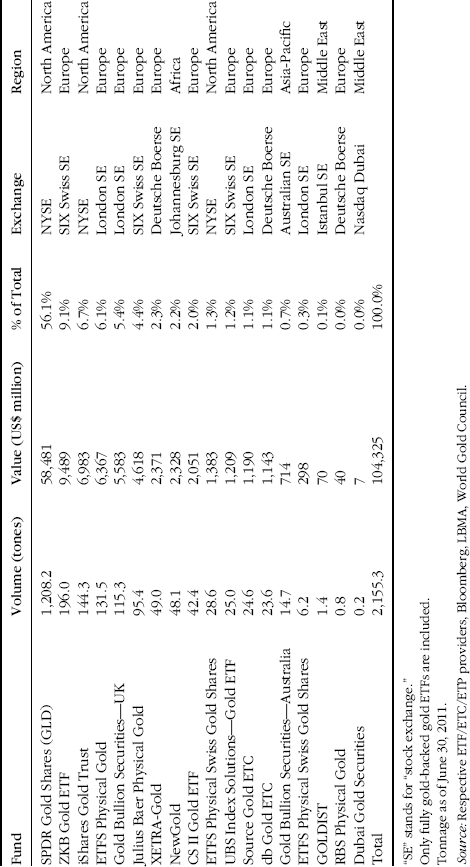
Though the speculative interest in gold has coincided with the growth of the gold ETF industry, and is not necessarily caused by the ETF, it is still easy to see how the introduction and availability of the gold ETFs has tremendously supported the rise in gold prices, and may even have acted as a multiplier.
Just take a look at Figure 3.11 to see how far gold prices have gone since the introduction of gold ETFs.
Did Gold ETFs Multiply the Gold Price?
In describing the precipitating structural factors that had led to irrational exuberance and the market bubbles of the late 1990s and 2000s, Shiller points to the “proliferation of equity mutual funds with the effect of encouraging speculative price movements in stock market aggregates, rather than in individual stocks.” Furthermore, the psychological aspect of new investment vehicles led to “the emerging popular concept that mutual fund investing is sound, convenient, and safe” and “has encouraged many investors who were once afraid of the market to want to enter it, thereby contributing to an upward thrust in the market.”13
The eerie similarity between the mutual funds that led to the bubbles of the late 1990s and the ETFs that have led to the gold bubble of the past decade is uncanny. The introduction of the gold ETFs has increased awareness, created the illusion that investing in gold through ETFs is sound and safe, and has encouraged many investors who were once afraid of gold investing to buy gold and thereby contribute to the “upward thrust” of the gold bubble.
The price of gold is up over $1,500 since the introduction of the gold ETFs. And though it is hard, if not impossible, to truly measure the effect of ETFs on investment demand, it could very well be argued that ETFs have sparked a lot of interest in gold, both by allowing new investors a way to invest in gold and by involving a multitude of market participants who would otherwise never come across gold as an investment idea. Notice the high correlation between ETF volume and the rising gold price in Figure 3.12.
Further ETF Risks: Proper Storage and Physical Backing
Although the GLD ETF is supposedly backed by gold bullion in London, there has been concern over the assurance of quantity, quality, and safety of the fund's holdings. One example of questionable and potentially fraudulent practices: According to the SPDR Gold Trust prospectus, “Gold bars allocated to the Trust in connection with the creation of a basket may not meet the London Good Delivery Standards.”14 Other questionable provisions in the prospectus that should raise red flags are ones that limit the liability of custodians and subcustodians responsible for the safekeeping of the gold in cases of fraud, damage, or theft.
The accusations15 and potential fraud have not been proved, but the ambiguous prospectus might be showing signs of speculation and questionable practices normally associated with risky asset bubbles. Furthermore, if such fraud does turn out to be true, the gold market will tumble. This is just another reason to watch out with gold.
Gold Miners Not Hedging
The lack of hedging by the mining companies, at the exact time when protecting themselves from declining gold prices is most important, stands as another warning signal of a speculative bubble in gold.
Dealing largely and almost exclusively with gold, gold mining companies are highly exposed to risk from gold price fluctuations. Since their profits depend heavily on the price of gold, and since they own gold for most months if not all year-round, gold miners would be correct and financially responsible in protecting their gold exposure risk. In fact, mining companies have historically protected themselves from sudden declines in gold prices by hedging their gold holdings with put options or other forms of derivatives that would limit their losses in case of such declines. And the higher the price of gold, the more dangerous the price decline is for the miners. Therefore, as the price is at an all-time historic high, the need for hedging should likewise be at an all-time high in order to protect the miners from sudden drops.
But because most of the miners think that gold prices are going to continue rising, they have recently stopped hedging themselves. At a time when protection is actually more important than at any time in the history of their businesses, they've joined the gold craze and essentially ceased to hedge. This is as counterintuitive as it gets; hedges are protections “just in case” prices go down. Miners seem to have forgotten that “just in case” is a small bet compared to the potential devastation they may be setting themselves up for.
As you can see in Figure 3.13, the trend in hedging has been a steady and steep decline since 2001. But with hedging near a multidecade low and gold prices at all-time highs, a reversal is likely. If the massive collapse of the homebuilder stocks during the housing bubble crash is a similar example, the fate of the gold mining companies looks very bleak with the coming of the gold bubble crash.
Huge Profit-Cost Gap
A large gap between the cost of mining and production (around $600 an ounce) and the actual selling price of gold ($1,900) points to overspeculative gold prices. As production costs stay relatively low in comparison to the market price of gold, mining companies are seeing large profits from the very wide spread between the cost of production and sale price. But such disparities between the production costs and market price may be signaling overextended and frothy gold prices.
While production costs have risen over 50 percent since 2007 (see Figure 3.14), mining companies are still seeing soaring profit margins, up nearly double since 2009 (see Figure 3.15).
With mining companies seeing profits of over 100 percent, a big shift may be underway.
In one scenario, the massive profit margins could entice new competitors to enter the gold mining space, which would increase costs of production, increase supply, and/or lower demand. If new competitors see the opportunity and increase the supply of gold by increasing production, the price of gold would drop.
As a second possibility, the huge profit margins brought about by the soaring gold prices could be signaling an overheated market for gold, since the price of production is so far below market price. Regardless, the wide gap between production costs and market price is not sustainable—either production costs must rise or gold market prices must fall.
Speculative Takeovers
Another sign of speculation and overreliance on future gold price increases is the number and size of takeovers by mining companies. Acquisitions are a good way for mining companies to grow their businesses and increase their gold exposure. But when gold prices are already at extremes, excessive takeover volume could signal a buying frenzy driven by the fear of losing out and the greed of wanting more. Excess takeover may signal the peak of popularity and an upcoming reversal. And with 2010 seeing the highest dollar volume in takeovers in decades, the speculative peak may be near. Notice the rising takeover volume in Figure 3.16
Figure 3.16 The Illusion of Opportunity Leads to Excessive Buying: Takeover Volume since 2000
Sources: Metals Economics Group, Bloomberg, Erste Group Research.
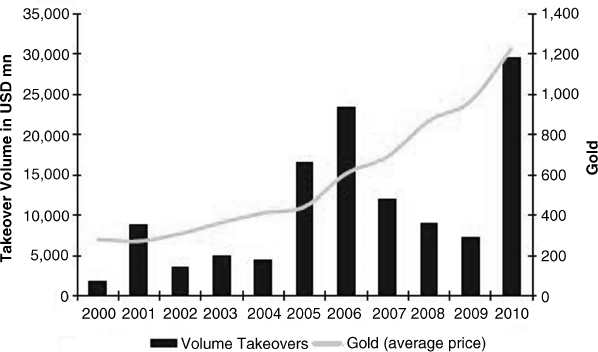
The one-year period from June 2010 to June 2011 saw 69 takeovers with an average deal of $881 million and an average premium of 40.98 percent.16 I am unsure of the average deal size and premium historically, but I would be willing to bet it is nowhere near as speculative as current levels. Moreover, the massive volume of takeovers and the dehedging we discussed earlier are signs of speculation by the mining companies themselves, not just the investors. With speculation on the part of investors, gold companies, financial institutions, and even some governments, the risks of a gold bubble threaten a wide range of potential victims.
Three striking examples in the mining sector highlight the mass overspeculation in gold.
1. Taxi Company Attempts to Buy a Mining Company: Perhaps one of the most shocking pieces of evidence that a bubble has formed is the attempt by Wah Nam, a Hong Kong taxi company, to buy an Australian mining company in April 2011.17 When a completely unrelated business attempts to enter a hot market, in our case a foreign limo service company attempting to buy a publicly traded Australian miner, red flags should appear. Such stories don't come out when a bubble is beginning; they come out when sentiment is at a positive extreme, near the peak.
2. Large Gold Miner Buys Copper Miner: One of the largest gold mining companies, Barrick Gold (ABX), recently announced a nearly $8 billion acquisition of copper miner Equinox. Since gold miners generally stick to gold, the large takeover of a copper miner could signal that the outlook for copper is very bullish going forward, and could also serve as a diversification for their gold holdings: “Barrick like other gold companies (is) looking to diversify their operations to some degree into metals where growth opportunities are not as expensive, but where commodity prices are still high and where the demand outlook is strong.”18
On the other hand, a large takeover of a copper miner by a gold mining company that has had 90 percent exposure to gold and has been largely a gold-only play may signal more than just diversification: “Barrick might be actually signaling to the market place that gold prices might be a little bit too high, and now it's starting to look to diversify away from gold.”19
3. Baby-Formula Producer Attempts to Enter Metals Market: Similar to the Hong Kong taxi company that attempted to enter the mining business, a Hong Kong–listed baby-formula producer attempted to enter the metals sector by loading up on loans and lending to metals companies. This is a sure sign of overspeculation, “when companies neglect their core business and start speculating in ‘hot’ sectors they know nothing about, especially with borrowed money.”20 These are blatant signs of a bubble.
Gold Vending Machines
It wasn't enough for gold to be bought at jewelry stores or through distributors directly. German company Ex Oriente Lux has now manufactured “Gold to Go” ATM vending machines and placed them across the globe, with 10 machines in Germany, two in Italy, one in the United Kingdom, six in the United Arab Emirates, and, ironically, even one in the gambling center of the world—Las Vegas.21 When coins or bars of gold can be purchased through vending machines, speculation has reached an extreme.
Unemployment Picture Points to Gold Bubble
While the United States is barely, if at all, coming out of the worst recession since the Great Depression, it is no wonder our current unemployment situation is the worst in over 60 years. And to make matters worse, with the United States and global economies showing signs of slowing, our menacing unemployment issues could escalate.
Yet one, and only one, industry has actually added jobs since the beginning of the recession in December 2007: mining. See Figure 3.17
Figure 3.17 U.S. Employment Change from December 2007
Source: Business Insider (www.businessinsider.com/category/chart-of-the-day).
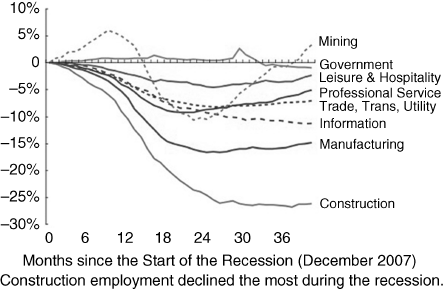
Understandably, the construction industry, most closely related to housing (which was the industry most severely hurt in the recession), has lost most of its jobs since December 2007. Likewise, our weak manufacturing sector, much of which has been shifted overseas, has lost more jobs than other industries.
But the mining sector, which has tremendously benefited from soaring prices in gold, silver, copper, platinum, palladium, oil, and other resources, has seen gains.
If every other industry in the economy is losing jobs, there has to be a good reason why mining would be gaining jobs. That reason, of course, is the massive increases in the price of gold and other precious metals—which have increased profits in the mining sector and therefore increased the requirement for hiring, as more employees are needed in the growing industry. In other words, mining companies are seeing bigger profits because they are selling their gold, silver, or whichever metal they work with for much more than before.
Then, to increase profits further, the mining companies hire more employees as they expand their operations or mine for more metal. At the same time, new mining companies are emerging because they've seen the soaring gold and metals prices, and want to profit from the theme by mining it themselves. There is no doubt then, that the increased hiring in the mining industry is pointing to an increase in optimism about the future profitability of mining, and in turn the underlying metals—gold, silver, and others. Based on this data then, we can safely say that, on the whole, the market and the mining companies themselves are expecting continued increases in metals prices.
Yet the soaring expectations by both mining companies and investors will not be met. World markets are entering recessions, commodity prices and demand are falling, the U.S. dollar is strengthening, and deflation is more likely to occur than inflation. Due to these conditions, gold and other metals will fall. The excess hiring in the mining industry is therefore a sign of overspeculation, overenthusiasm, and overconfidence in gold, silver, and other metals.
The addition of jobs in the mining industry points to overinflated prices in the underlying metals. It makes sense why mining would benefit more than the other industries, since rising gold and silver prices have boosted profitability in the sector. But with mining being the only industry gaining jobs since December 2007, signs of overspeculation are evident.
Mining should be a “relative outperformer.” It should be doing better than the other industries, but not necessarily doing well. In other words, if every part of the economy is getting hit hard, mining should at least get hit. Mining would therefore be a “relative outperformer” if its job losses were not as massive as the other industries. When mining is the only industry that gains jobs, however, unjustified metals prices may be to blame. Gold and precious metals have deserved an increase in prices as fears over the global economy spread; but such massive increases, with gold reaching nearly $2,000 an ounce, are very risky and unsustainable.
Gold bugs would say the increased hiring in the mining industry is a sign of higher future prices and a continuation of the gold and precious metals theme. But considering slowing global economies, a strengthening dollar, deflationary concerns, and tremendously unsustainable commodity and precious metals prices, the excess hiring in the mining industry points to extreme speculation and overconfidence in gold, silver, and precious metals.
Gold Is Not Enough
First, investors flocked to gold through the GLD ETF. Then, they jumped into the gold miners ETF (GDX) for higher returns. Then they dove into the junior miners (GDXJ). The further down the line investors go, the higher the speculation and, in turn, the risk.
But the gold and gold miners weren't enough, so investors have moved on to other derivative plays on gold—silver (SLV), platinum (PPLT), palladium (PAL), copper (JJC), rare earth elements (REE), Molycorp (MCP), and the GLTR ETF, just to name a few. These moves by investors are not only evidence of the extreme belief that gold prices will continue to rise, but are also signs of massive risk-taking and a potential expansion of the gold bubble, as investors flock to these stocks and ETFs simply due to the fact that they are related to gold.
Rare-Earth CEO “Mistakenly” Calls It a Bubble22
The contagion of the gold and precious metals bubble has been highly visible in the run-up in other metals, commodities, and even rare-earth elements. And if my opinion isn't enough to convince you, maybe the CEO of Molycorp calling the rare-earth space a bubble will.
On CNBC's Fast Money on October 21, 2010, the CEO of Molycorp (a rare-earth producer) mistakenly called the rare-earth space a bubble. I say “mistakenly” because no CEO wants to call his business a bubble. Rather, CEO Mark Smith was just completely unprepared and perhaps even foolish when he said:
I also don't think that these short-term prices are things that people ought to be counting on because they are really spiked right now and we think there may be a form of a bubble occurring because of all of the news and the frenzy that's occurring.23
Such a misstep, in calling his own business a bubble, could have proved to be devastating. It was true that Smith thought there was a bubble underway, but revealing that to the public could send Molycorp's stock plunging as investors would quickly sell their positions to avoid the upcoming drop. So with the right public relations strategy behind him, Smith attempted to take back his real opinions by telling Bloomberg seven days later:
I don't believe there is a bubble. . . .These prices are absolutely sustainable and that's really based upon the very simple facts of supply and demand.24
Then, appearing again on CNBC's Fast Money on December 21, Smith explained his completely contradictory statements (probably choosing to keep his real opinions to himself and protect his company's stock from falling). When asked what happened that would cause him to completely change his outlook on what he had called a bubble, Smith responded:
Well, I got a lot smarter, number one. And I learned how to do interviews a lot better. . . .We are absolutely bullish on prices. We think these prices are absolutely sustainable and we think that the simple supply and demand fundamentals support the prices that we are bullish on.25
A complete change of opinion, from thinking a bubble is occurring to saying prices are “absolutely sustainable,” are blatant signs of manipulation and irresponsibility on Smith's part. It is almost obvious from his comments that he was told what to say in order to protect his company, even at the cost of lying to investors. Furthermore, the initial acknowledgment of a “frenzy” and bubble occurring in the space is an additional signal that the gold mania had spilled over to other precious metals and commodities, and has highly increased the speculation and risk involved in the growing bubble.
Rare earth metals have shown other signs of overspeculation and potential fraud. First, the name “rare earth elements” is a misnomer since most of these 17 elements are actually not so rare. Second, much of the exorbitant price increase can be attributed to the misconception that China has a near-monopoly on rare-earth minerals. However, there exist a number of other rare-earth mines in the United States and elsewhere. China only appears to control the industry because it employs cheap labor that has made it economically inefficient for Western-world mines to compete until now. Moreover, the shock that put rare-earth minerals at the forefront of investor attention and caused a huge increase in prices was China's ban of rare-earth exports to Japan in September 2010. The dispute between China and Japan brought massive publicity to rare-earths and has further fueled the speculative mania for these minerals.26
Several signs of potential fraud and manipulation have surfaced as well. Other than Molycorp's CEO calling the sector a bubble and then mysteriously retracting his claims, another rare-earth company appears to be engaged in some shady business. Rare Earth Elements (REE), which has also benefited tremendously from rare-earth overspeculation, is not even in operations mode until 2015 when it opens its mine. Moreover, its management seems to be engaged in highly suspicious activity. First, the CEO, CFO, and Corporate Secretary are involved as managers or directors for 12 additional companies. These three individuals are interconnected and intertwined through a number of similar companies—none of which has moved beyond the exploration phase of the business. Not only do these companies operate at a deficit, but management has been paid hundreds of thousands of dollars through fees and stock-based compensation at the expense of the shareholders. Furthermore, management has failed to adequately disclose the major conflicts of interest that exist between the companies in which they have a vested interest—and to which over $1,000,000 in fees has been billed from shareholder investment.27
With gold's massive run, investors have flocked to silver, copper, palladium, rare earth elements, and other precious metals for the “next big thing.” What many fail to realize, however, is that if we are currently in a gold bubble, many of the precious metals will also collapse as the gold bubble deflates.
At the source of a speculative bubble are lofty and unrealistic expectations that support the parabolic price increases and justify the mass overspeculation that fuels the bubble. These extreme expectations by investors are the result of flawed valuations, faulty historical comparisons, and a high degree of emotion.
Extreme expectations for gold can be linked to a number of reasons and rationalizations.
Lack of Traditional Investment Valuations
A major characteristic of speculative bubbles is the lack of ways to correctly value the underlying asset. Many bubbles, such as the technology bubble of the late 1990s, develop and grow due to giant expectations of the future success or appreciation of the often-misunderstood asset.
So it is natural to expect that an information cascade is especially likely to develop in response to a genuinely new and different investment opportunity, one that is completely outside the realm of most investors' personal experience. And this is exactly what is happening when we hear talk about new industries and new technologies that promise to revolutionize the economy.28
With the tech bubble, investors thought the Internet was the future and their investments would only keep rising in value. Spurred on by the growing use of the Internet and the speculation that this new technology was the wave of the future, stock prices soared as investors piled into Internet-based companies, sometimes simply based on the fact that they included an “e-” prefix or a “.com” ending to their names. And though investors were correct in assuming that the Internet and technology were the future of business, the exorbitant prices they were willing to pay for companies that hadn't even turned in a profit should have stood as a stark warning.
But what could investors have done? The Internet was rapidly gaining in popularity, stock prices were soaring, and the argument that this was a “new age,” where old valuation measures no longer applied, was becoming the norm. Things were “different this time,” and you'd be crazy not to join the party.
Yet while investors were correct in asserting that the Internet and technology companies were the wave of the future, their expectations got a little ahead of themselves, and their blind faith in almost any company in the technology space was unwarranted. If you joined the party too late, you would have lost almost everything.
Similar to the technology bubble, gold also involves an asset that is hard to truly value. It has been the main source of wealth for thousands of years and throughout the globe, yet it is hard to determine what it's truly worth. Its value is affected by inflation, deflation, war, economic crisis, and so forth—factors that are nearly impossible to evaluate or determine with certainty. Instead, gold prices have been highly influenced by speculation about upcoming world events, as well as uncertainty and fear.
Appeals to Fear and Emotion
Human psychology and its extreme opposition to fear make gold an almost perfect candidate for a bubble that preys on emotion.
Affirmative messages that build crowd unity are not usually appeals to the intellect of crowd members. Instead they are appeals to emotion, to stereotypes, to dreams or fears. The language of persuasion and crowd solidarity is the language of drama, not science.29
Gold prices have skyrocketed largely due to the intense fear and uncertainty about the future of the economy and the speculation that we're approaching a time of massive turmoil. Buying due to such passionate fears makes gold's appeal to emotion a strong enabler for a speculative bubble.
Fifth wave advances in the stock market are propelled by hope, while fifth wave advances in commodities are propelled by a comparatively dramatic emotion, fear: fear of inflation, fear of drought, fear of war.30
These “fifth waves” are the final moves before sharp and devastating declines.
“It's Different This Time”
As in most bubbles and overly euphoric investor behavior, the argument that “this time things are different” has surfaced once again. In the dot-com bubble the argument was that the “new age of technology and the Internet” was here. In the housing bubble, land values were going to continue to soar because land was only to continue to be scarce as population grew and people needed homes; the extravagant prices were seen as a result of new valuations for homes. Now, gold's value is considered to be “different this time” because global markets are interconnected, economies are at high risk, and currency systems are seen as highly unstable. But are things really so different now? Arguments of a “new paradigm” and “new era” are many times accompanied by peaks in asset prices or ends of popular themes.
Faulty Historical Comparison
Originally published November 23, 2010: “Why Inflation Isn't Affecting Gold Prices,” Seeking Alpha.31
The often-used argument by gold bugs has been that the gold price, if adjusted for inflation, is still considerably below the record highs of the early 1980s. And since we are still below the early 1980s prices when we adjust for inflation, we should not be concerned about a gold bubble. Even more, the argument claims that since we are well below inflation-adjusted record prices in gold, we can expect gold prices to continue to run up significantly before a peak is in place. In other words, they claim that $2,000 an ounce gold is still not expensive because $2,000 in 2011 is worth less than $700 in the early 1980s.
However, I have four issues, at least, with these claims.
1. Rampant inflation in 1970s, not now Gold price records of 1980 came at a time of soaring inflation. Inflation was at 13.5 percent in 1980! Compare that to 2009 where we had negative inflation, and to 2010 and 2011 when we are averaging less than 5 percent inflation—nowhere near the 13.5 percent as in 1980. Even in China and fast-growing emerging markets, inflation is closer to 6 percent. Since inflation “inflates” prices, it is understandable why gold prices skyrocketed in the early 1980s in order to reflect the surge in overall prices. But at a time when inflation is far from soaring (at least in comparison to the early 1980s), much of the speculation in gold today is due to uncertainty and fears about the future, rather than the reality that supported gold's rise in the late 1970s.
As you can see in Figure 3.18, the 1980 gold price high was accompanied by huge percentage increases in the Consumer Price Index (CPI), which tracks price changes in a broad basket of goods and services, as a measure of inflation. Over the next 25 years, gold prices were generally stable as the CPI grew between 1 and 6 percent annually. But starting in 2005, we all of a sudden have a huge divergence between gold prices and the CPI. In other words, we would expect gold prices to rise and fall in accordance with changes in the CPI—if the CPI soars we would expect gold prices to rise as well, and if the CPI falls we would expect gold prices to fall or at least grow modestly. But that's not the case here; the gold price surged together with CPI in 1980, but is completely diverging from CPI since 2005. If anything, we should be seeing gold prices stagnate or even drop a little to match the lower inflation rates of the past few years.
Figure 3.18 Inflation, CPI All Items (Seasonal Adjustment)
Source: U.S. Department of Labor, Bureau of Labor Statistics; Chartfacts.
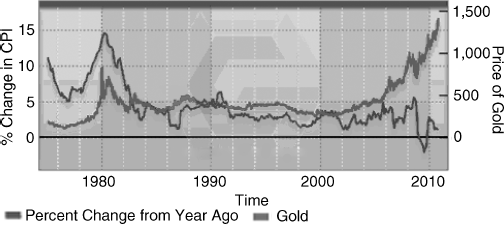
2. Largest divergence between real gold prices and inflation-adjusted gold prices Not only are gold prices diverging from the yearly CPI changes, but they are also diverging from themselves (see Figure 3.19.)
Figure 3.19 Inflation, CPI All Items (Seasonal Adjustment)
Source: U.S. Department of Labor, Bureau of Labor Statistics; Chartfacts.
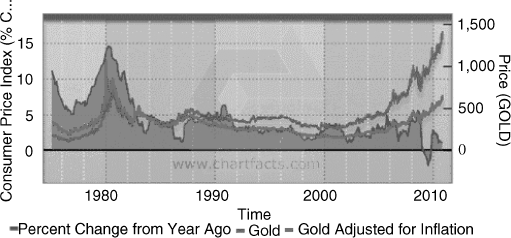
While real gold prices and gold prices adjusted for inflation have generally remained close, they have diverged from each other to a huge extent since 2005. In the early 1980s, the two prices were almost identical, and even overlapped. But in 2010, we had real prices at $1,400 while the inflation-adjusted price of $644 lagged by over 50 percent. Either the inflation-adjusted price has to catch up, or the $1,500-plus real gold price has to drop. With such a massive and unprecedented divergence between the two, I'd bet on option B.
3. Gold is up way more than inflation As CPI is up less than 30 percent since 2000, gold is up over 500 percent. If CPI is a good measure of overall inflation, we'd expect prices of most items to increase, or decrease, in accordance with changes in the CPI. Therefore, if the CPI increases by 30 percent, we'd expect most items to increase in a range around that 30 percent; prices of food may rise 35 percent, but prices of energy could rise only 25 percent, for example. But when we see the price of one item increase by 500 percent, as gold has in this case, we should question whether such a move is justified, as prices of the rest of the things we could buy are not even close to moving that rapidly (see Figure 3.20). As CPI has essentially flat-lined since 2005, gold is up almost threefold.
Figure 3.20 Inflation, CPI All Items (Seasonal Adjustment)
Source: U.S. Department of Labor, Bureau of Labor Statistics; Chartfacts.
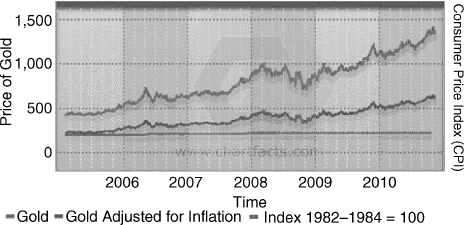
4. Price highs from 1980 stand as strong resistance against much higher prices Since gold lacks intrinsic value, unlike stocks, and relies mainly on supply and demand, previous high prices play an even greater role. In our case, the inflation-adjusted price highs of the 1980s (between $1,700 and $2,400) could present heavy selling pressure, as investors reconsider their gold investments as prices approach previous all-time highs. Not only is the $2,000 level a major psychological resistance level, where many investors would likely sell their gold; but the lack of soaring inflation, which justified surging gold prices in the 1970s, poses major barriers to a continuation of gold price increases at current times.
In conclusion, though we have not surpassed the record high price of gold in 1980 when we adjust for inflation, we have certainly doubled the record in real prices, we currently have no soaring inflation that would justify the huge price moves (as it did in the 1970s), and we have the largest divergence ever between real prices and inflation-adjusted prices. In other words, gold is moving much faster than inflation, and maybe even too fast.
There has been concern over the reliability and accuracy of the inflation data provided by the CPI (see Figure 3.21). Some have claimed that the CPI is fundamentally flawed and that inflation is higher than shown by the CPI. But in my opinion either outcome supports a gold bubble:
If CPI is flawed, we've had higher inflation, and therefore it makes sense that gold is up. But the extent of gold's rise and the upcoming deflation will hurt gold and commodities.
On the other hand, if the CPI is right, we've had low inflation, which should not have caused such huge price increases in gold (as was the case in the late 1970s).
The price of gold has risen over 600 percent since 1999, but the CPI, which measures inflation, is up only around 30 percent. Gold has been bought due to inflation expectations, but with the increase in gold prices heavily outweighing actual inflation, extreme speculation may have pushed gold way beyond reasonable levels.
A similar scenario played out in the 1970s, when gold surged hundreds of percent to the 1980 high of $850 an ounce before starting a collapse and a 19-year bear market in gold. In the words of financial-crises expert, Charles Kindleberger:
The 1970s was a decade of accelerating inflation, the largest sustained increase in the U.S. consumer price level in peacetime. The market price of gold surged initially because some investors relied on the cliché that “gold is a good inflation hedge” as the basis for their price forecasts; however the increase in the gold price was many times larger than the contemporary increase in the U.S. price level. Toward the end of the 1970s investors were buying gold because the price of gold was increasing—and the price was increasing because investors were buying gold. 32
Not only does our current gold bubble show remarkable similarities to the one during the 1970s, where gold prices far outpaced inflation and eventually imploded; but our current situation is even more dangerous, because current inflation is nowhere near the high levels that were present in the 1970s. If anything, the threat of recession may be signaling an upcoming deflationary phase, in which inflation is negative. And if inflation is negative, asset prices will fall and gold will not gain as investors are expecting it to.
From 1971 to 2001, gold and bonds moved together. But since 1999—when I claim our current gold bubble began—gold has skyrocketed while bonds have continued to decline. The failure to move together, as was the case historically, could be pointing to an irrational price for one of them—either gold is too high, or bonds are too low. They will likely converge again, and chances are that gold has formed a bubble and will soon collapse in order to resume historical correlation to bonds.
Intolerance of Opposing Views
One of the strongest signs of herd mentality is the fear of taking the opposite view. So far, I have yet to see strong opinions in opposition to gold—someone who puts his money where his mouth is. And when I do see individuals claiming gold to be a bubble, their claims are met with heavy opposition and ridicule. This ridicule and scorn (visible in the comment sections of many antigold articles on the Internet) are undoubtedly signs of intense bias and strong emotional ties to the gold theme; and breaking from these biases or emotions is extremely hard to do—especially when one's money is invested.
We therefore can understand why gold-bubble claims are met with heavy opposition: because those invested in gold have a high interest in continued price increases. But when the ridicule becomes so one-sided and intense, especially when it's backed by faulty logic or extreme expectations, signs of a speculative crowd emerge. Strong and vehement opposition to antigold individuals is therefore substantial proof that the gold bubble is nearing saturation.
Herd-Like Price Targets
Originally published March 30, 2011: “The Impending Collapse of the Gold Bubble,” Seeking Alpha33
Gold price-targets range from $1,000 to $15,000. Who is right?
Virtually no one is willing to bet against gold. Even among those who think gold is a bubble or risky investment, there are very few, if any, people actually willing to bet against it. Though it's generally a very smart move to avoid betting against a stock or investment theme with a lot of momentum behind it, the fact that even gold bears are shying away from betting against it may signal that it is a bubble with extremely high bullish sentiment. If the gold bears won't bet against it, is there really much room left for gold to run? What happens if these gold bears finally gather the courage to start betting against it?
Moreover, if we look at the huge number of price-target estimates made by institutions, investment professionals, analysts, and the gold mining companies themselves—only 2 out of over 100 estimates are below $1,400! And most of them are far beyond the current price. Such extreme bullishness should be met with severe caution at the very least. The lack of dissenting opinion is highly unsettling.
But—I could be wrong. At least that's what almost every analyst, bank, mining company, investor, and financial institution thinks. Gold price targets for 2011 range from anywhere near $1,000 to as high as $15,000. The larger financial institutions are clustered near $1,500 though. And considering that gold is currently selling near $1,500, does it really pay to take on the potentially large risk when consensus estimates have already been reached? If you do think it is worth it, you should hope some of the individuals predicting $2,000 or $15,000 gold are right.
Here is a comprehensive and exhaustive list of gold price projections (as of March 30, 2011):
| Analyst/Company | 2011 Gold Price Target |
| Morgan Stanley | $1,512 |
| Goldman Sachs | $1,650 |
| JP Morgan | $1,650–$1,700 |
| Jeffries | $1,400 |
| Barclays | $1,850 |
| Bank of America | $1,500 |
| UBS | $1,400 |
| Citigroup | $1,450 |
| Deutsche Bank | $1,600 |
| Société General | $1,425 |
| Jim Rogers | $2,000 |
| CIBC | $1,600 |
| Jon Nadler, Kitco | $1,150 |
| IBIS World | $1,150–$1,210 |
| Scotia Capital | $1,400–$1,500 |
| Mark Bristow, CEO Randgold Resources | $1,500 |
| Chuck Jeannes, CEO Goldcorp | $1,500–$2,300 |
| Sean Boyd, CEO Agnico-Eagle | $1,600 |
| Mark Cutifani, CEO AngloGold Ashanti | $1,300–$1,500 |
| Aaron Regent, CEO Barrick Gold | $1,500 |
| Jeff Pontius, CEO International Tower Hill | $1,500 |
| Jochen Hitzfeld, Unicredit | $1,500 |
| Bretton Woods Research | $1,500 |
| Harmony Gold | $1,500 |
The following is a full list of gold price projections, with extreme expectations clearly noticeable.34
Higher Than $10,000
1. Mike Maloney: $15,000
2. Ben Davies: $10,000–$15,000
3. Howard Katz: $14,000
4. Dr. Jeffrey Lewis: $7,000–$14,000
5. Jim Rickards: $4,000–$11,000
6. Roland Watson: $10,800 (in our lifetime)
$5,000–$10,000
1. Bob Kirtley: $10,000 (by 2011)
2. Arnold Bock: $10,000 (by 2012)
3. Porter Stansberry: $10,000 (by 2012)
4. Tom Fischer: $10,000
5. Shayne McGuire: $10,000
6. Eric Hommelberg: $10,000
7. Anonymous: $6,410–$10,000 (by 2012–2016)
8. David Petch: $6,000–$10,000
9. Gerald Celente: $6,000–$10,000
10. Egon von Greyerz: $6,000–$10,000
11. Peter Schiff: $5,000–$10,000 (in 5 to 10 years)
12. Patrick Kerr: $5,000–$10,000 (by 2011)
13. Peter Millar: $5,000–$10,000
14. Roger Wiegand: $5,000–$10,000
15. Alf Field: $4,250–$10,000
16. Peter George: $3,500 (by 2011–2013); $10,000 (by Dec. 2015)
17. Jeff Nielson: $3,000–$10,000
18. Dennis van Ek: $9,000 (by 2015)
19. Dominic Frisby: $8,500
20. James Turk: $8,000 (by 2015)
21. Joseph Russo: $7,000–$8,000
22. Michael Rozeff: $2,865–$7,151
23. Martin Murenbeeld: $3,100–$7,000
24. Jim Willie: $7,000
25. Dylan Grice: $6,300
26. Chuck DiFalco: $6,214 (by 2018)
27. Aubie Baltin: $6,200 (by 2017)
28. Murray Sabrin: $6,153
29. Samuel “Bud” Kress: $6,000 (by 2014)
30. Robert Kientz: $6,000
31. Harry Schultz: $6,000
32. Lawrence Hunt: $5,000–$6,000 (by 2019)
33. Martin Hutchinson: $3,100–$5,700
34. Jeremy Charlesworth: $5,000+
35. Przemyslaw Radomski: $5,000+
$5,000
1. David Rosenberg: $5,000
2. Doug Casey: $5,000
3. Peter Cooper: $5,000
4. Robert McEwen: $5,000
5. Martin Armstrong: $5,000 (by 2016)
6. Peter Krauth: $5,000
7. Tim Iacono: $5,000 (by 2017)
8. Christopher Wyke: $5,000
9. Frank Barbera: $5,000
10. John Lee: $5,000
11. Barry Dawes: $5,000
12. Bob Lenzer: $5,000 (by 2015)
13. Steve Betts: $5,000
14. Stewart Thomson: $5,000
Up to $5,000
1. Pierre Lassonde: $4,000–$5,000
2. Willem Middelkoop: $4,000–$5,000
3. Mary Anne and Pamela Aden: $3,000–$5,000 (by February 2012)
4. James Dines: $3,000–$5,000 (in June 2011)
5. Goldrunner: $3,000–$5,000 (by 2012)
6. Bill Murphy: $3,000–$5,000
7. Eric Janszen: $2,500–$5,000
8. Larry Edelson: $2,300–$5,000 (by 2015)
9. Luke Burgess: $2,000–$5,000
10. Jeff Nichols: $2,000–$5,000
11. Jim Sinclair: $1,650–$5,000
$3,000–$4,000
1. Mike Knowles: $4,000
2. Ian Gordon/Christopher Funston: $4,000
3. D.P. Baker: $3,000–$3,750 (by Jan./Feb. 2012)
4. Adam Hamilton: $3,500 (by 2010–2011)
5. Christopher Wood: $3,360
6. Eric Roseman: $3,500+
7. John Henderson: $3,000+ (by 2015-2017)
8. Hans Goetti: $3,000
9. Michael Yorba: $3,000
10. David Tice: $3,000 (by 2012)
11. David Urban: $3,000
12. Mitchell Langbert: $3,000
13. Brett Arends: $3,000
14. Ambrose Evans-Pritchard: $3,000
15. Trader Mark: $3,000 (by mid-2011)
16. John Williams: $3,000
17. Louise Yamada: $3,000 (by 2016-2017)
18. Byron King: $3,000
19. ThumbCharts.com: $3,000
20. Bob Chapman: $3,000 (by 2011)
21. Ron Paul: $3,000 (by 2020)
22. Chris Weber: $3,000 (by 2020)
$2,500–$3,000
1. Ian McAvity: $2,500–$3,000 (by 2012)
2. Graham French: $2,000–$3,000
3. Joe Foster: $2,000–$3,000 (by 2019)
4. Sascha Opel: $2,500+
5. Rick Rule: $2,500 (by 2013)
6. Daniel Brebner: $2,500
7. James DiGeorgia: $2,500
Signs of a gold bubble are numerous and even shocking. Aside from the classic and quantitative sign of a bubble—the massive and parabolic run-up in price—investors' extreme enthusiasm and euphoria over gold have been accompanied by massive publicity, media frenzy, overspeculation, surging and unsustainable investment demand, a multitude of ETF investment vehicles, highly risky behavior by the miners, a huge gap between the low cost to produce gold and the high selling price, irrational expectations about the future, and herd-like behavior.
These warning signs are out there, but the bubble continues because gold investors refuse to accept them. Led by many talking heads who make passionate arguments supporting gold, the herd that invests appears to have great reasons to do so. The herd also has strength in numbers, which it uses as another reason to support its speculative behavior; ironically, many gold investors also claim that not enough people have bought gold and that many more will do so in the future. Moreover, expectations about future prices reach extremes because gold does not have a traditional way of being valued; almost any price could be argued, as long as believable reasons are given. Prices also surge because gold investing appeals to fear and emotion, which can cause panic buying and justify nearly any price. This strong emotional component of the bubble also allows for faulty historical comparisons that make gold prices appear to be reasonable and even cheap. Investors claim that “things are different this time” and buying gold is the smart thing to do.
But one does not have to look so hard to see how widespread and speculative the gold theme has become. “We Buy Gold” stores are everywhere, gold is a major focus on TV and news, gold advertisements fill websites and magazines, and nearly all banks and financial institutions think gold prices will continue to rise. Most shockingly, gold speculation has filtered through to nearly all sectors of the market—with examples of a taxi company and a baby-formula maker attempting to enter the metals business; and gold is even being sold in vending machines. Profitable and safe investments do not involve such massive media attention and extreme enthusiasm. Instead, gold investing is extremely risky and misleading.
In the next chapters, we show how overvalued gold has become by comparing it to other asset classes and presenting the case for why gold is not recession-proof. We also present an in-depth analysis of gold's massive price increases over the past 40 or more years, and discuss the number of factors that gold's future relies on. Now that we have seen the many warning signs pointing to a bubble, we can attempt to predict exactly at what stage of the bubble we currently find ourselves and what circumstances could trigger its collapse.
